New near infrared spectroscopy products at Pittcon 2016
Submitted by ianm on 19 April 2016 - 1:47pm
Ian Michael
IM Publications, 6 Charlton Mill, Charlton, Chichester, West Sussex PO18 0HY, UK. E-mail: [email protected]
There was really quite a wide spread of new NIR spectroscopy products at Pittcon; fNIRS, miniature, FT-NIR, probes and software. As always, due to the number of exhibitors and size of the exhibition, we may have missed something. If your NIR spectroscopy product was genuinely new at Pittcon, please let me know so we can include it in a future issue.
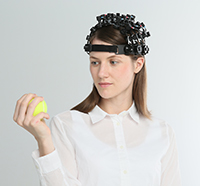 In Issue 7 in 2015 we covered the LABNIRS functional near infrared spectroscopy (fNIRS) system from Shimadzu. There is now a new version, LIGHTNIRS. This fits inside a specially designed backpack and has a lithium ion battery which enables measurements to be made on subjects during real-life activities as well as making it easy to take the instrument to various locations. LIGHTNIRS and its software enable multi-brain imaging with synchronisation of up to four LIGHTNIRS units. Class 1, three-wavelength semiconductor lasers and photodiode detectors are used, and the integrated probe design enables a unique mounting of the fibre optic and optode holder device for a sensitive connection to the head.
In Issue 7 in 2015 we covered the LABNIRS functional near infrared spectroscopy (fNIRS) system from Shimadzu. There is now a new version, LIGHTNIRS. This fits inside a specially designed backpack and has a lithium ion battery which enables measurements to be made on subjects during real-life activities as well as making it easy to take the instrument to various locations. LIGHTNIRS and its software enable multi-brain imaging with synchronisation of up to four LIGHTNIRS units. Class 1, three-wavelength semiconductor lasers and photodiode detectors are used, and the integrated probe design enables a unique mounting of the fibre optic and optode holder device for a sensitive connection to the head.
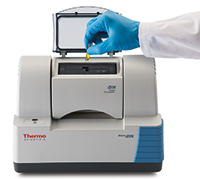 Thermo Scientific’s Nicolet iS5 small FT-IR spectrometer has been around for a few years, and now an NIR version has been introduced, the iS5N. Wavelength range is ~900–2630 nm and detection is via an extended range InGaAs detector. The instrument measures 35 cm wide × 28 cm deep and weighs 10 kg. The iS5N uses the same software as other Thermo Scientific Nicolet FT-IR spectrometers. OMNIC Lite software supports routine operation, and the TQ Analyst EZ or Pro software can be used for calibration model development. A heated transmission accessory, the iD1A, is also a new addition. http://bit.ly/iS5NFTNIR
Thermo Scientific’s Nicolet iS5 small FT-IR spectrometer has been around for a few years, and now an NIR version has been introduced, the iS5N. Wavelength range is ~900–2630 nm and detection is via an extended range InGaAs detector. The instrument measures 35 cm wide × 28 cm deep and weighs 10 kg. The iS5N uses the same software as other Thermo Scientific Nicolet FT-IR spectrometers. OMNIC Lite software supports routine operation, and the TQ Analyst EZ or Pro software can be used for calibration model development. A heated transmission accessory, the iD1A, is also a new addition. http://bit.ly/iS5NFTNIR
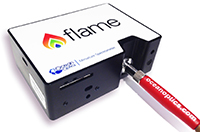 Ocean Optics had three new products. They have added an NIR version to their Flame spectrometer family. Flame-NIR includes a small optical bench and an uncooled InGaAs diode array detector covering the ~950–1650 nm range. It is designed to provide high thermal stability and it offers low unit-to-unit variation. It is available pre- or custom configured, with a replaceable slit design that enables users to adjust optical resolution and throughput on demand. Operation of the Flame-NIR is plug-and-play, with a choice of USB or RS-232 communications, supported by drivers and software enabling integration into most systems. http://bit.ly/flamenir
Ocean Optics had three new products. They have added an NIR version to their Flame spectrometer family. Flame-NIR includes a small optical bench and an uncooled InGaAs diode array detector covering the ~950–1650 nm range. It is designed to provide high thermal stability and it offers low unit-to-unit variation. It is available pre- or custom configured, with a replaceable slit design that enables users to adjust optical resolution and throughput on demand. Operation of the Flame-NIR is plug-and-play, with a choice of USB or RS-232 communications, supported by drivers and software enabling integration into most systems. http://bit.ly/flamenir
The higher end NIRQuest spectrometer has been enhanced with all models now coming with a replaceable slit design as standard. Also, there is the option of adding an internal shutter to manage light throughput and dark measurements. http://bit.ly/nirquest
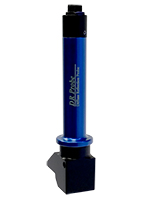 Ocean Optics were also showing their line of spectroscopy accessories for dynamic sampling of both liquids and solids, averaging signal across the sample. The diffuse reflectance probe integrates a light source and collection optics to measure 45° diffuse reflectance. It has an all-metal construction with 40-mm focal length and 10,000 hour bulb. The DynaCup is a rotating device that presents samples to the DR Probe. A multiplexer accessory saves sample measurement time and streamlines sample processing. It is a mechanical actuator that distributes light through 10 customisable channels from a single light source. Two models offer a choice between fast positioning, and high repeatability and accuracy of performance. http://bit.ly/dynamicsampling
Ocean Optics were also showing their line of spectroscopy accessories for dynamic sampling of both liquids and solids, averaging signal across the sample. The diffuse reflectance probe integrates a light source and collection optics to measure 45° diffuse reflectance. It has an all-metal construction with 40-mm focal length and 10,000 hour bulb. The DynaCup is a rotating device that presents samples to the DR Probe. A multiplexer accessory saves sample measurement time and streamlines sample processing. It is a mechanical actuator that distributes light through 10 customisable channels from a single light source. Two models offer a choice between fast positioning, and high repeatability and accuracy of performance. http://bit.ly/dynamicsampling
The 3-A certification is an established hygiene standard in the USA, ensuring that all surfaces that come into contact with food are very easy to clean and sterilise. Hellma Analytics have introduced the Excalibur 25 Hygienic 3-A immersion probe for UV/vis/NIR, which is both FDA and USDA compliant. It incorporates leakage detection and provides a reduced risk of impurities and cross-contamination. It will find application in areas such as dairy products, beer and spirits, soft drinks and juices, cooking oils, sweeteners, and pharmaceuticals. http://bit.ly/3aprobe
StellarNet introduced the StellarCASE-NIR, an NIR system in a portable rugged case for “open & measure” applications. The case includes the spectrometer instrumentation mounted within and pre-configured, with no additional setup required. Press the “Analyze” button and match results or sample % composition are displayed on the screen. The NIR reflectance fixture mounts directly into the system’s acrylic surface for easy access. The system’s reflectance fixture contains a high-stability tungsten halogen source and patent-pending, three-dimensional collection optics. Standard systems are equipped with an InGaAs detector for the 900–1700 nm range with options for extended range 1700–2300 nm configurations. http://bit.ly/NIRcase
 Viavi Solutions (previously JDSU) introduced three new versions of their MicroNIR spectrometer. The MicroNIR PAT-U is designed for real-time process monitoring in food and pharmaceutical PAT applications. With no moving components or fibre optic cables it provides instrument stability in harsh environments, with the stainless steel exterior of IP67 standard and being easy to clean. It can be mounted into process equipment using either a standard mount, which can be disassembled easily for cleaning, or a threaded mount which has a removable window. http://bit.ly/microNIRPAT
Viavi Solutions (previously JDSU) introduced three new versions of their MicroNIR spectrometer. The MicroNIR PAT-U is designed for real-time process monitoring in food and pharmaceutical PAT applications. With no moving components or fibre optic cables it provides instrument stability in harsh environments, with the stainless steel exterior of IP67 standard and being easy to clean. It can be mounted into process equipment using either a standard mount, which can be disassembled easily for cleaning, or a threaded mount which has a removable window. http://bit.ly/microNIRPAT
The MicroNIR PAT-W is also a process spectrometer, designed for monitoring in blend homogeneity, loss on drying, compaction, content uniformity and other PAT applications. It comes with user-selectable WiFi or Ethernet communication; when used on a rotating blender an integrated 9-axis inertial measurement unit and a 3-axis accelerometer provide repeatable and accurate triggering of the spectrometer. The case is IP67 rated and the same mounting options as above are available. http://bit.ly/microNIRPAT
 The MicroNIR OnSite is the latest handheld version. It comes with two applicators with sapphire windows, AR-coated on one side for maximum light throughput. The large applicator is for soft materials such as fibre, clothes and vegetation. The small applicator provides flexible operation and ease of use in reaching samples in confined spaces. It connects to a Windows-based tablet or laptop which runs the professional version of Viavi’s data acquisition, method development, user management and real-time prediction software. http://bit.ly/MicroNIROnSite
The MicroNIR OnSite is the latest handheld version. It comes with two applicators with sapphire windows, AR-coated on one side for maximum light throughput. The large applicator is for soft materials such as fibre, clothes and vegetation. The small applicator provides flexible operation and ease of use in reaching samples in confined spaces. It connects to a Windows-based tablet or laptop which runs the professional version of Viavi’s data acquisition, method development, user management and real-time prediction software. http://bit.ly/MicroNIROnSite
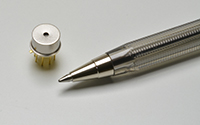 Hamamatsu Photonics introduced a single element detector that is able to give spectral information by utilising a Fabry–Perot interferometer, the MEMS FPI C13272. A voltage controls the size of the gap between two mirrors in a MEMS structure. The size of this gap determines the wavelength of light that is allowed to pass through. By quickly changing the voltage across these mirrors, the structure acts as a tuneable filter. This means that the user effectively has a spectrometer but with the low cost and small footprint of a single element sensor. http://bit.ly/MEMSFPI
Hamamatsu Photonics introduced a single element detector that is able to give spectral information by utilising a Fabry–Perot interferometer, the MEMS FPI C13272. A voltage controls the size of the gap between two mirrors in a MEMS structure. The size of this gap determines the wavelength of light that is allowed to pass through. By quickly changing the voltage across these mirrors, the structure acts as a tuneable filter. This means that the user effectively has a spectrometer but with the low cost and small footprint of a single element sensor. http://bit.ly/MEMSFPI
Metrohm introduced new client/server software, Vision Air. There are two parts to the software. Vision Air Routine focuses on the needs of routine users and Vision Air Manager on administrative and calibration functions. Vision Air Routine enables analysis with two clicks: choosing the operating procedure and starting the analysis. Results are presented simply, and the quality evaluated immediately, supported by simple colour coding. No training is required. Vision Air Manager allows all settings and models and methods for the routine user to be set up, along with instruments and their settings, as well as control over users’ roles and permissions. When combined with Vision Air Server, any number of spectrometers can be connected in a network, with the storage of results and data on a server offering increased security. http://bit.ly/VisionAir
We have mentioned Si-Wave Systems’ NeoSpectra FT-NIR sensors before, but they have now started volume production with the SWS62221 model. These are not complete instruments, but modules that can be used to build a complete mobile spectrometer. Three different configurations between 1150 nm and 2500 nm are available. They predict “We foresee the day in the near future where spectroscopy becomes an essential part of our daily activities”! http://bit.ly/neospectra
Finally, an interesting cloud-based software service for most spectroscopy and chromatography analytical and bioanalytical data. BSSN Software’s Seahorse Web Edition enables native data files from most instrument manufacturers and techniques, as well as common standard formats such as JCAMP-DX to be uploaded and explored. Data can easily be annotated and shared with external collaborators. Web, mobile and desktop clients are included with the service. The model will be pay-as-you-go, per user, per month. A beta programme is currently underway which you can apply to join at http://bit.ly/1nNM8bI.